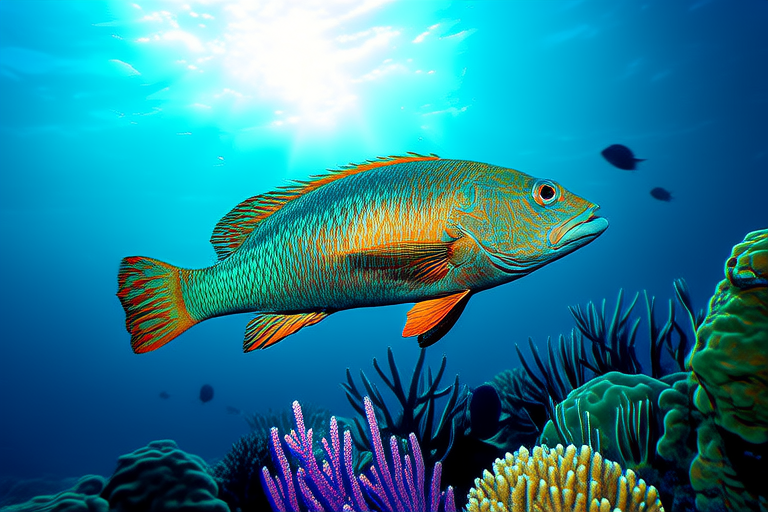Meet the Masterpieces of the Sea: Discovering the Majestic Parrot Fish
In the vast and colorful realm of the ocean, few creatures capture the imagination quite like the parrot fish. These mesmerizing marine dwellers are not just another pretty face in the sea; they are key players in maintaining the delicate balance of coral reefs. With their striking appearance and unique behaviors, parrot fish are truly masterpieces of the sea. Let us dive into the world of these fascinating creatures, exploring their physical attributes, behaviors, and vital roles within marine ecosystems.
The Vibrant Palette of Parrot Fish
Parrot fish are renowned for their dazzling array of colors, making them stand out among other marine species. From electric blues and fiery reds to soft pinks and greens, their bodies are painted with nature’s most vivid hues. This vibrant palette serves multiple purposes, from camouflage to attracting mates. The male parrot fish, in particular, often displays more intense and varied coloration compared to females. Their bright colors also play a significant role in communication, helping individuals recognize each other during courtship rituals or territorial disputes.
One of the most remarkable features of parrot fish is their ability to change color throughout their lives. Juveniles may start off with muted tones before gradually developing more vibrant shades as they mature. Some species even undergo dramatic transformations, shifting between different color phases depending on factors such as age, sex, and social status. This dynamic display of coloration adds an element of mystery and wonder to these already captivating creatures.
Habitat Preferences and Behavior
Parrot fish inhabit tropical and subtropical waters around the globe, favoring warm, shallow regions teeming with coral reefs. They are primarily found in areas where there is an abundance of coral, seagrass beds, and rocky substrates that provide both shelter and food sources. Coral reefs serve as vital nurseries for many marine species, including parrot fish, offering protection from predators and ample opportunities for feeding.
These social animals often gather in large schools, especially when resting or migrating. However, during feeding times, they tend to break away from the group to graze on algae-covered corals. Using their powerful beak-like mouths equipped with fused teeth called a pharyngeal mill, parrot fish scrape algae off rocks and coral surfaces. This feeding behavior has earned them the nickname “the gardeners of the reef,” as they help maintain healthy coral by removing excess algae growth.
Parrot fish exhibit fascinating sleeping habits that further highlight their uniqueness. At night, many species retreat to secluded crevices within the reef structure where they secrete a protective mucus cocoon. This slimy barrier acts as a deterrent against potential predators and parasites, providing added security while the fish rest. Some believe this mucus might even mask their scent, making it harder for nocturnal hunters to locate them.
The Ecological Role of Parrot Fish
Beyond their aesthetic appeal, parrot fish play crucial roles in maintaining the health and biodiversity of coral reefs. By consuming large quantities of algae, they prevent overgrowth that could smother corals and disrupt the delicate balance of reef ecosystems. Additionally, their feeding activities contribute to nutrient cycling within the reef environment. As they process algae through their digestive systems, waste products rich in nutrients are released back into the water, benefiting other organisms.
Another important contribution made by parrot fish is their production of sand. When they grind up coral skeletons while feeding, tiny particles of calcium carbonate are produced. Over time, these fragments accumulate on the seabed, forming what we know as sandy beaches. Without the constant recycling of materials facilitated by parrot fish, many coastal areas would lack the fine grains necessary for beach formation.
Conservation Challenges and Efforts
Despite their importance, parrot fish populations face numerous threats due to human activities. Overfishing remains one of the most significant challenges, as demand for their meat continues to rise globally. In some regions, unsustainable fishing practices have led to declines in local parrot fish numbers, affecting overall ecosystem stability. Habitat destruction caused by pollution, climate change, and coastal development further exacerbates these issues, reducing available space for parrot fish to thrive.
To address these concerns, various conservation initiatives have been launched worldwide aimed at protecting parrot fish and their habitats. Marine protected areas (MPAs) play a critical role in safeguarding vulnerable species by restricting harmful activities within designated zones. By creating safe havens where parrot fish can reproduce and grow undisturbed, MPAs help ensure sustainable populations over time.
Education campaigns targeting consumers and fishermen alike also form part of broader efforts to promote responsible practices. Raising awareness about the value of parrot fish in maintaining healthy reefs encourages more mindful consumption patterns and supports sustainable fishing methods. Collaboration between governments, NGOs, and local communities is essential for implementing effective strategies that benefit both people and wildlife.
A Call to Action
The majesty of parrot fish lies not only in their striking appearance but also in their indispensable role within marine ecosystems. As stewards of our oceans, it is our responsibility to protect these magnificent creatures and preserve the vibrant underwater worlds they inhabit. By supporting conservation projects, advocating for stronger environmental policies, and making conscious choices as consumers, we can contribute to ensuring a future where parrot fish continue to grace our seas with their beauty and vitality.
Let us join forces in safeguarding parrot fish populations and their habitats. Together, we can make a difference and secure a brighter tomorrow for these underwater masterpieces.
